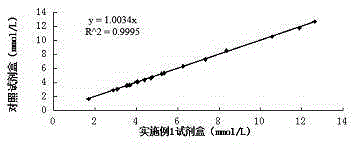Total cholesterol detection reagent with high accuracy and disturbance resisting capacity
A technology for total cholesterol and detection reagents, applied in the field of total cholesterol detection reagents, to achieve the effect of improving stability, improving accuracy and removing interference
- Summary
- Abstract
- Description
- Claims
- Application Information
AI Technical Summary
Problems solved by technology
Method used
Image
Examples
Embodiment 1
[0040] 1) A total cholesterol detection reagent with high accuracy and strong anti-interference ability, the composition of the reagent R is as follows:
[0041] Reagent R contains:
[0042] CAPS buffer (pH7.0) 50mmol / L
[0043] 4-aminoantipyrine 1.0mmo1 / L
[0044] Cholesterol esterase (CHE) 2000U / L
[0045] Cholesterol oxidase (CHO) 2000U / L
[0046] Peroxidase (POD) 2500U / L
[0047] Sodium 3,5-dichloro-2-hydroxybenzenesulfonate (DHBS) 3.5mmol / L
[0048] Magnesium chloride 2.5mmol / L
[0049] Trehalose 20g / L
[0050] Mannitol 20g / L
[0051] Hydroxyethylidene diphosphonic acid 2ml / L
[0052] Octadecyltrimethylammonium bromide · 0.3g / L
[0053] EMULGEN-7070.35ml / L
[0054] Ascorbate oxidase 2.5KU / L,
[0055] Bilirubin oxidase 2KU / L
[0056] Preservative 0.5ml / L
[0057] 2) Detection usage method:
[0058] The total cholesterol detection reagent described in this example is used in an automatic biochemical analyzer, such as a Hitachi 7180 automatic analyzer, and is ...
Embodiment 2
[0063] Correlation experiment: using the formula in Example 1 to prepare reagents, and conducting a control test with the total cholesterol kit of a company approved by the State Food and Drug Administration, which is common in the market, and testing 20 clinical serum samples at the same time, the test results are shown in Table 2 Show. And obtained the correlation curve of the two reagents (such as figure 1 shown).
[0064] Table 2 Example 1 reagent and market common and recognized total cholesterol assay kit comparative detection results
[0065]
[0066] The test results show that the correlation coefficient of the two kits is 0.9997, which shows that the two have a great correlation, and the stabilizer and anti-interference agent added in the reagent of Example 1 do not affect the accuracy of the reagent. Show that the reagent of embodiment 1 has good accuracy.
Embodiment 3
[0068]Interference test: take fresh mixed serum, divide it into 2 equal parts, and then divide each equal part into 5 equal parts, add different interfering substances, so that the concentration in the serum reaches the requirements in Table 3. Then respectively use Example 1 and the control reagent (same as Example 2) to simultaneously measure the content of total cholesterol in serum by comparison, and the measurement results of each group after adding different interfering substances are shown in Table 3. Relative deviation (%) = (measuring mean value of interfering samples - measuring mean value of samples without interfering substances) / measuring mean value without interfering substances × 100%.
[0069] Table 3 embodiment reagent anti-interference performance comparison
[0070]
[0071] It can be seen from Table 3 that the reagent of Example 1 has no obvious interference on the test results when ascorbic acid≤2000μmol / L, bilirubin≤986μmol / L, and hemoglobin≤10.5g / L....
PUM
| Property | Measurement | Unit |
|---|---|---|
| wavelength | aaaaa | aaaaa |
Abstract
Description
Claims
Application Information
 Login to View More
Login to View More - R&D
- Intellectual Property
- Life Sciences
- Materials
- Tech Scout
- Unparalleled Data Quality
- Higher Quality Content
- 60% Fewer Hallucinations
Browse by: Latest US Patents, China's latest patents, Technical Efficacy Thesaurus, Application Domain, Technology Topic, Popular Technical Reports.
© 2025 PatSnap. All rights reserved.Legal|Privacy policy|Modern Slavery Act Transparency Statement|Sitemap|About US| Contact US: help@patsnap.com



